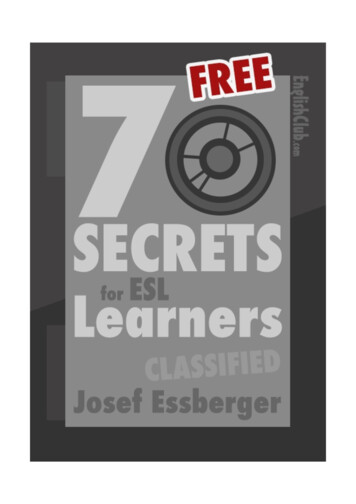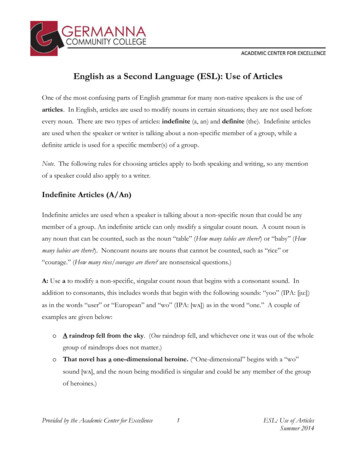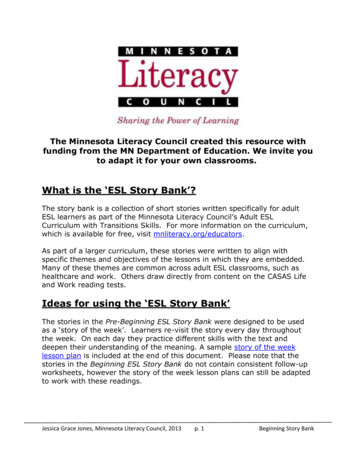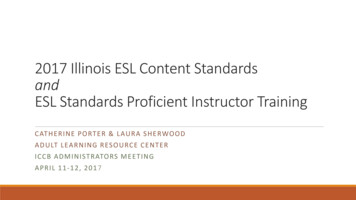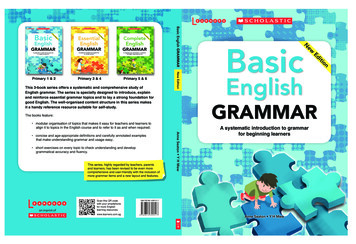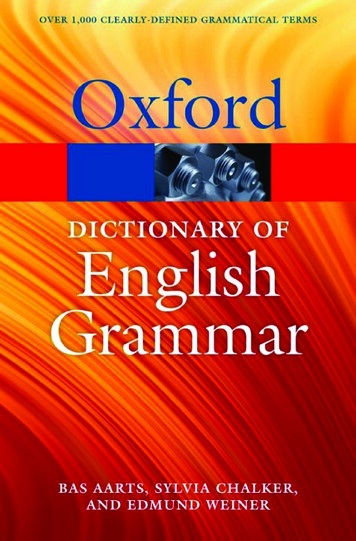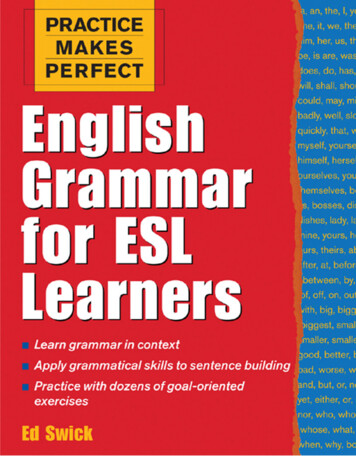
Transcription
PRACTICEMAKESPERFECTEnglishGrammarfor ESLLearners
This page intentionally left blank.
PRACTICEMAKESPERFECTEnglishGrammarfor ESLLearnersEd Swick
Copyright 2005 by The McGraw-Hill Companies, Inc. All rights reserved. Manufactured in the UnitedStates of America. Except as permitted under the United States Copyright Act of 1976, no part of thispublication may be reproduced or distributed in any form or by any means, or stored in a database orretrieval system, without the prior written permission of the publisher.0-07-146535-9The material in this eBook also appears in the print version of this title: 0-07-144132-8.All trademarks are trademarks of their respective owners. Rather than put a trademark symbol after everyoccurrence of a trademarked name, we use names in an editorial fashion only, and to the benefit of thetrademark owner, with no intention of infringement of the trademark. Where such designations appear inthis book, they have been printed with initial caps. McGraw-Hill eBooks are available at special quantitydiscounts to use as premiums and sales promotions, or for use in corporate training programs. For moreinformation, please contact George Hoare, Special Sales, at george hoare@mcgraw-hill.com or (212)904-4069.TERMS OF USEThis is a copyrighted work and The McGraw-Hill Companies, Inc. (“McGraw-Hill”) and its licensorsreserve all rights in and to the work. Use of this work is subject to these terms. Except as permitted underthe Copyright Act of 1976 and the right to store and retrieve one copy of the work, you may notdecompile, disassemble, reverse engineer, reproduce, modify, create derivative works based upon,transmit, distribute, disseminate, sell, publish or sublicense the work or any part of it without McGrawHill’s prior consent. You may use the work for your own noncommercial and personal use; any other useof the work is strictly prohibited. Your right to use the work may be terminated if you fail to comply withthese terms.THE WORK IS PROVIDED “AS IS.” McGRAW-HILL AND ITS LICENSORS MAKE NOGUARANTEES OR WARRANTIES AS TO THE ACCURACY, ADEQUACY OR COMPLETENESSOF OR RESULTS TO BE OBTAINED FROM USING THE WORK, INCLUDING ANYINFORMATION THAT CAN BE ACCESSED THROUGH THE WORK VIA HYPERLINK OROTHERWISE, AND EXPRESSLY DISCLAIM ANY WARRANTY, EXPRESS OR IMPLIED,INCLUDING BUT NOT LIMITED TO IMPLIED WARRANTIES OF MERCHANTABILITY ORFITNESS FOR A PARTICULAR PURPOSE. McGraw-Hill and its licensors do not warrant or guaranteethat the functions contained in the work will meet your requirements or that its operation will beuninterrupted or error free. Neither McGraw-Hill nor its licensors shall be liable to you or anyone else forany inaccuracy, error or omission, regardless of cause, in the work or for any damages resulting therefrom. McGraw-Hill has no responsibility for the content of any information accessed through the work.Under no circumstances shall McGraw-Hill and/or its licensors be liable for any indirect, incidental,special, punitive, consequential or similar damages that result from the use of or inability to use the work,even if any of them has been advised of the possibility of such damages. This limitation of liability shallapply to any claim or cause whatsoever whether such claim or cause arises in contract, tort or otherwise.DOI: 10.1036/0071465359
Want to learn more?We hope you enjoy thisMcGraw-Hill eBook! Ifyou’d like more information about this book,its author, or related books and websites,please click here.
For more information about this title, click hereContentsIntroductionviiUnit 1Nouns1Unit 2Definite and Indefinite Articles6Unit 3Adjectives9Unit 4Personal Pronouns12Unit 5Verbs17Unit 6Auxiliary Verbs44Unit 7Passive Voice49Unit 8Subjunctive Mood53Unit 9Adverbs59Unit 10Contractions62Unit 11Plurals65Unit 12Punctuation68Unit 13Infinitives and Gerunds75Unit 14Relative Pronouns77Unit 15Reflexive Pronouns83Unit 16Possession86Unit 17Possessive Pronouns88Unit 18Prepositions92Unit 19Capitalization95Unit 20 Comparative and Superlative FormsUnit 2199Conjunctions106Unit 22 Interrogatives110v
viContentsUnit 23 Negation115Unit 24 Numbers120Unit 25 Some Important Contrasts125Appendix: Common Irregular Verbs133Answer Key135
IntroductionMany people consider learning grammar a chore. And at times, it can be. But understanding thegrammar of any language is essential for becoming a skilled and accurate user of that language.English is certainly no exception.The rules of grammar for a language learner are like the rules of the road for a driver. In orderto be able to drive properly and maneuver with other drivers, you have to know the rules thateveryone goes by. Naturally, some people break the rules and make driving difficult for otherdrivers. This is true of language, too. If you follow the rules of grammar, you can express yourselfclearly. But if you fail to observe those rules, people may find it difficult to understand you orthey may even misunderstand you entirely. So it’s really very important to understand and usecorrect grammar.But what is grammar? Funk and Wagnalls’s New College Standard Dictionary describes grammar as“a type of science that explains the various principles of oral or written usage of a particular language.” It is also said to be “the developed art of speaking or writing accurately in a particularlanguage.” Whether science or art, grammar is made up of the descriptions that tell you how touse a language correctly. For example:Description: Begin a sentence with do to change a statement to a question.Usage: Statement “You understand the problem.”Question “Do you understand the problem?”Or:Description: Use he as the subject of a sentence; use him as the direct object.Usage: Subject “He is a good friend of mine.”Direct Object “I visit him very often.”There are many such grammatical descriptions, and each one is a building block in the structureof your knowledge of how to form and use English correctly. The greater the number of building blocks that you master, the greater your accuracy with the spoken and written language willbe.Standard grammar is composed of the traditional rules for English. It is what grammarians andEnglish professors want everyone to use when they speak and write. But a language evolves overtime, and the traditional rules sometimes seem out of step with what is going on in the Englishspeaking world. The more current or popular usages can be called casual language. That’s whatpeople really say in their everyday lives and is often in direct contradiction with standard grammar. As an illustration, in standard grammar you should use who as the subject of a sentence anduse whom when it is used as an object. But that’s not always the case in casual language. Forexample:Standard grammar: “Whom did you visit in New York?”Casual language: “Who did you visit in New York?”viiCopyright 2005 by The McGraw-Hill Companies, Inc. Click here for terms of use.
viiiIntroductionAlthough the first example is considered better grammatically, the second example sentence isthe most commonly used.Another kind of example involves the verb to dive. Its past tense is either regular (dived) or irregular (dove). What is the difference? Essentially, none. Both forms are used correctly as the pasttense. But English is evolving. Things are changing. And the English-speaking world is decidingwhether it wants the past tense of the verb to dive to be regular or irregular. It may take quite awhile longer to learn what that decision will be. So for the time being you’ll continue to hearboth dived and dove in the past tense.There is a similar case with the verb to prove. Nowadays, many people use proved as the participlein a perfect tense: “He has proved” or “We had not proved.” But there are others who still usethe archaic form (proven), which today is generally accepted as an adjective, in place of proved:“He has proven” or “We had not proven.”The point here is that grammar rules will guide you toward speaking and writing better English.But many rules of grammar are broken by certain casual or popular usages and still othersbecome unclear because the language is in a state of transition. Where these deviations occur,they will be discussed in this book, because if English learners only know that who should be usedas a subject of a sentence, they will be confused by what occurs in casual language: “Who did youvisit in New York?”However, just knowing the rules of grammar is not enough. This book will also provide you withabundant practice in using English grammar. The more you practice, the more you become proficient in how you use English and to what extent you understand it. There are various kinds ofexercises to allow you to manipulate the language from different angles. The Answer Key at theend of the book gives you not only the right answers but also suggestions as to how an exerciseshould be completed.English grammar isn’t necessarily a chore. Indeed, it can be your key to unlocking a very richtreasure.
Unit 1NounsNouns can be either proper or common. Proper nouns are those thatrefer to a particular person, place, thing, or idea. Such nouns arecapitalized: America, George Washington, Mr. Neruda, October.Nouns that do not refer to a particular person, place, thing, or ideaare common nouns. They are not capitalized: land, girls, money, test.Compare the following list of proper and common nouns:Proper NounsCommon NounsMexicoMs. FinchEnglishMcGraw-HillAmerican nymonthexercise1-1Next to each noun write the word proper or common.1.France2.rope3.United States4.Professor Hall5.professor6.the stadium7.the Olympics8.horses1Copyright 2005 by The McGraw-Hill Companies, Inc. Click here for terms of use.
2Practice Makes Perfect: English Grammar for ESL Learners9.Dr. Blanchard10.our schoolexercise1-2Rewrite each noun, capitalizing the proper nouns.1.glass2.rocky mountains3.mexico4.flowers5.bus6.the store7.new york times8.roberto9.professor romano10.my booksNouns can be used as the subject of a sentence. The subject is the word that is performing theaction in the sentence. The subject can be a proper noun or a common noun, and it can be singular or plural:Juanita is a friend of mine.The boys like to play soccer.Where is the school?Nouns can also be used as direct objects. The direct object in a sentence is the noun that receivesthe action of the verb. To find the direct object in a sentence do three things:1. Find the subject of the sentence.2. Find the verb in the sentence.3. Ask whom or what with the subject and the verb.Look at these sample sentences:“Sara likes my brother.”“The girls find a book.”1. subject Sara2. verb likes1. subject girls2. verb find
Nouns3. ask whom Whom doesSara like?3. ask what What do thegirls find?The direct object is my brotherThe direct object is book.3Nouns are sometimes indirect objects. They stand before the direct object in the sentence. It is theperson to whom or for whom something is provided. To find the indirect object in a sentencedo three things:1. Find the subject of the sentence.2. Find the verb in the sentence.3. Ask to whom or for whom with the subject and the verb.Look at these sample sentences:“Justin buys the girl a magazine.”“Mother gives Nate five dollars.”1. subject Justin2. verb buys3. ask to whom or for whom Forwhom does Justin buy a magazine?1. subject Mother2. verb gives3. ask to whom or for whom To whomdoes Mother give five dollars?The indirect object is girl.The indirect object is Nate.Note: It is rare that something inanimate is used as an indirect object.When a noun is used as a predicate noun, it follows the predicate in the sentence. The predicatecan be a single verb or a verb phrase:Verb as the predicate: Maria helps us.Verb phrase as the predicate: Maria usually helps with the gardening.Predicate nouns most often follow the verbs to be and to become:My mother wants to be a doctor.Celine became an actress.Are you the manager of this building?exercise1-3Look at the italicized word in each sentence. Decide how it is used, then write subject, direct object, indirectobject, or predicate noun in the blank.1.Claudia likes Bret.2.The boys found some money.3.The girls found some money.4.My father is an engineer.5.I sent my sister a telegram.6.Tomas buys Serena three red roses.
4Practice Makes Perfect: English Grammar for ESL Learners7.Is the woman at home now?8.Mr. Jimenez became a pilot.9.He needs a new car.10.Carmen gives them the books.exercise1-4Write a sentence using the noun given as a direct object.EXAMPLE: the boyBarbara sees the boy in the park.1. my sister2. a new car3. JackieWrite a sentence using the word given as an indirect object.4. the children5. a puppy6. Grandfatherexercise1-5Using the phrase in parentheses, answer each question using that phrase as the direct or indirect object.EXAMPLE: (Yolanda) Whom does Gerry meet?Gerry meets Yolanda.1. (the boys) Whom does the girl not trust?
Nouns2. (his wallet) What does Father often misplace?3. (the landlord) To whom does she always give the rent money?4. (her new computer) What does Anita want to sell soon?5. (her grandchildren) For whom does she buy the toys?6. (Ms. Johnson) Whom must you visit in New York?7. (their new house) What do they like so much?8. (little Johnny) To whom can she give the present?9. (Dr. Lee) Whom does he need to see today?10. (Michael) To whom does she throw the ball?5
Unit 2Definite and IndefiniteArticlesThe English definite article is the. It is used to identify a particularperson or thing. If you are speaking about someone or somethingyou are already familiar with, you use the with the noun. Look atthese examples:I already know the man.She met the women who won the lottery.This is the book that I told you about.The indefinite article is used to describe someone or somethingthat is unfamiliar to you or about which you are speaking ingeneral. There are two forms: a and an. Use a before a wordbeginning with a consonant. Use an before a word beginning witha vowel. Look at these examples:He sees a stranger on the corner.Did you buy an apple or an orange?Is the woman a good lawyer?She has an idea.Compare the difference between the definite and indefinite articleby using these sentences:I want an apple. (I do not see an apple. But I feel hungry forone.)I want the apple. (I am choosing between the apple and theorange that I see before me.)The definite article for plural nouns is also the. But there is noindefinite article for plural nouns. The plural articles are used inthe same way as the singular articles.6Copyright 2005 by The McGraw-Hill Companies, Inc. Click here for terms of use.
Definite and Indefinite ArticlesSingular DefiniteSingular IndefinitePlural DefinitePlural Indefinitethe boythe housethe ideaa boya housean ideathe boysthe housesthe ideasboyshousesideasexercise2-1Fill in the blank with either the definite or indefinite article, whichever makes the best sense.1. Did you buy a Ford orChevy?2. Does he knowman on the corner?3. She hassecret to tell you.4. What time doestrain leave?5. We needhot dogs and a bottle of Coke.6. Did you seeaccident?7. He met8.guests as they arrived.teacher is angry with us.9. I can’t findkeys.10. Is that snake in that tree?exercise2-2Rewrite each sentence, changing the singular nouns in each sentence to plural nouns. Make any changes to thearticles and verbs that are necessary.1. They gave us an orange.2. I like the book very much.3. Do you often visit the farm there?7
8Practice Makes Perfect: English Grammar for ESL Learners4. A rabbit is hiding behind it.5. Katrina likes to play with the kitten.Follow the same directions, but change the plural nouns to singular.6. Montel has dogs and cats.7. I want to buy the roses.8. There are gifts for you.9. Can you hear the babies crying?10. Do you have brothers or sisters?
Unit 3AdjectivesAdjectives are words that describe nouns. They tell the size, color,or quality of something: a big room, the red car, four interestingbooks. Here are some commonly used longslowwrongexercise3-1Circle the adjective that makes more sense in the sentence.1. I often go to a green/late movie.2. Their little/right boy is six years old.3. The wrong/young teacher is very smart.4. We took the fast/loose train to New York.5. The old/funny story made me laugh.6. Do you know that handsome/early man?7. She had an early/careless breakfast.8. I saw the long/terrible accident.9. The new house has boring/white doors.10. The green/short boy is my cousin.9Copyright 2005 by The McGraw-Hill Companies, Inc. Click here for terms of use.
10Practice Makes Perfect: English Grammar for ESL LearnersJust like nouns, adjectives can follow the predicate. They most often come after forms of theverbs to be and to become :My sister was very sad.The horse suddenly became thirsty.My grandfather is old.exercise3-2Look at the example sentences. Change each sentence so that the adjective follows the predicate.EXAMPLE: The white house is on the hill.The house on the hill is white.1. The sad song was from Mexico.2. The funny story is about a clown.3. The careless waiter is out of work.4. The ugly snake is from Egypt.5. The beautiful woman is from Spain.exercise3-3Fill in the blank with any adjective that makes sense. You may choose from the list given at the beginning of theunit.1. David wrote a2. Do you like thepoem for her.cake?3. I cannot find anbook.4. Where does thelawyer live?5. Marisa needs a6. Thejob.man found awallet.
Adjectives7. Kareem is a8. There is afriend of mine.test tomorrow.9. When can you come to our10. That is afarm?question.11
Unit 4Personal PronounsPronouns are words that take the place of nouns. The English personal pronouns are:First PersonSecond PersonThird PersonSingularPluralIyouhe, she, itweyoutheyNotice that you is both singular and plural. When speaking to oneperson, say you. When speaking to two or more persons, say you:Tim, you are a very good student.Bruno and Rene, you have to study more.Just as nouns have gender, pronouns also do. I, we, and you can beused by males or females. He is always masculine, she is always feminine, and it is always neuter. The plural of the third-person pronouns is always they, whether masculine, feminine, or neuter. Andjust like nouns, pronouns can be used as:1. the subject of a sentence2. a direct object3. an indirect objectBut when used as a direct object or indirect object, some of thepronouns change:SubjectDirect ObjectIndirect ObjectIyouhesheitweyou outhem12Copyright 2005 by The McGraw-Hill Companies, Inc. Click here for terms of use.
Personal Pronouns13If a pronoun replaces a noun in the sentence, it must have the same characteristics as the noun:the same number (singular or plural), the same gender (masculine, feminine, or neuter), andthe same use in the sentence (subject, direct object, or indirect object). Look at these exampleswhere the pronoun replaces the italicized noun:Joseph is a hard worker.(singular masculine noun/subject) He is a hard worker.(singular masculine pronoun/subject)Do you know the girls?(plural noun/direct object) Do you know them?(plural pronoun/direct object)We gave Mrs. Jones some flowers.(singular feminine noun/indirect object) We gave her some flowers.(singular feminine pronoun/indirect object)Notice that the nouns and pronouns are in the third person. This is true when a pronounreplaces a noun. But when a noun or pronoun is combined with the first-person singular pronoun I, it is replaced by the first-person plural pronoun we :You and I have work to do. We have work to do.He helps the girls and me. He helps us.exercise4-1Look at the pronoun given in parentheses. Fill in the blank in the sentence with its correct form.1. (you) How aretoday?2. (he) Caleb gave3. (she)a gift.lives on Main Street.4. (it) I really don’t like5. (I) She met6. (Kris and I) Please give7. (you and I)8. (they) Are9. (we) The puppy followed10. (they) My brother saw11. (you) Mikhail wants to visit12. (I) When can13. (it) Derrick bought.in the city.the magazines.worked in the garden.your friends?home.in New York.today.move into the apartment?in Mexico.
14Practice Makes Perfect: English Grammar for ESL Learners14. (you and I) The children are helping15. (she) I likeexercise.a lot.4-2Change the italicized noun in each sentence to the corresponding pronoun.1. The students came to class late.2. I found the money in the closet.3. Her brother sent Jennifer and me a postcard.4. Do your parents live in Florida?5. My landlady is very nice.6. Do you know my landlady?7. Boys can get so dirty.8. Did you lose your wallet?9. Juan visits his uncle often.10. May I borrow your watch?exercise4-3Change the italicized pronoun in each sentence to any appropriate noun.1. We often speak English.2. Do you like it?3. Where did you find them?4. She is from Puerto Rico.5. Patricia never met him before.6. Is he sick today?7. We sent them a box of candy.8. It costs twenty dollars.
Personal Pronouns159. The boys watched her.10. Do they understand us?When you change a direct object noun to a direct object pronoun, you must add to or for beforethe indirect object noun or pronoun. The indirect object becomes the object of the prepositionto or for. Place the prepositional phrase after the direct object. For example:I gave Jay a book. I gave it to Jay.We buy her flowers. We buy them for her.exercise4-4Rewrite each sentence, changing the italicized direct object to a pronoun. Add to or for appropriately.1. I sent my friends a letter.2. She is giving us two cakes.3. Trey sold her his car.4. I didn’t buy Ella the scarf.5. My brother will bring me my gloves.Nouns or pronouns can be used to complete a prepositional phrase. That is a phrase made up of apreposition and a noun or a pronoun. Here are some of the most commonly used prepositions:after, behind, between, for, from, in, near, on, of, through, to, with, withoutLook at these sample prepositional phrases:after the concertbetween the girlsfrom a friendnear the cityof a bookto a studentwithout the moneybehind mefor youin himon itthrough herwith uswithout themIn a prepositional phrase, use the same form of the pronoun that is used as a direct or indirectobject:
16Practice Makes Perfect: English Grammar for ESL LearnersSubject PronounDirect or Indirect ObjectPrepositional PhraseIyouhesheitwetheymeyouhimheritusthemafter mebehind youfor himfrom herin itbetween usnear themexercise4-5Complete the sentences changing the subject pronoun in parentheses to an object pronoun.1. (I) They have a gift for.2. (you) I sent some flowers to.3. (he) Karen often comes home without4. (she) I like dancing with.5. (it) We found something in6. (we) Teresa sits near.7. (they) This is a letter from.8. (Dwayne and I) He is speaking of.9. (you and I) Someone is standing behind10. (he) You can come in afterexercise4-6Change the italicized noun to a pronoun.1. We are driving through the tunnel.2. A wolf was standing between the boys.3. Do you want to ride in my car?4. The guests have something for Julia.5. I like singing with Mr. Garcia.6. Maria is sitting near Ali and me.7. I get postcards from the tourists.
Unit 5VerbsVerbs are the words in a sentence that describe the action of a sentence or that introduce the condition or state of someone or something in the sentence.Action: Anna throws the ball.Introduction of a condition: Trent is very sick.There are many action verbs. Those that can have a direct object areoften called transitive verbs. Here is a list of some commonly usedtransitive verbs. Note that they can be used with a direct object.Transitive VerbsUsed in a eakwriteunderstandHe buys a newspaper.I am carrying the child.Can you find the book?She helps us.I don’t like cabbage.Don’t lose your money.She is reading a book.The dentist pulled the tooth.The boy pushes the cart.I am selling my car.Father speaks Spanish.We are writing some postcards.Do you understand me?Intransitive verbs are not followed by a direct object. They oftenshow a movement to a place and are sometimes followed by aprepositional phrase. Following is a list of some commonly usedintransitive verbs:17Copyright 2005 by The McGraw-Hill Companies, Inc. Click here for terms of use.
18Practice Makes Perfect: English Grammar for ESL LearnersIntransitive VerbsUsed in a velwalkCan you come to the party?The baby crawls on the floor.We are driving fast.I flew here from Paris.Are you going home?We hurry to the window.Peter jumps from the roof.I am riding in his car.The girls run past the school.We are sailing to Europe.Do you want to travel with us?I walk out of the theater.Still other verbs introduce the condition or state of someone or something. They do not take adirect object and are most often followed by an adjective. These verbs are usually called linkingverbs. Here are some commonly used linking verbs:Linking VerbsUsed in a steThe boy appears quite well.I am hungry.The weather becomes bad.It feels hot.The dog is growing weak.She looks unhappy.The coat seems too small for you.The pizza smells good.The music sounds awful.The popcorn tastes salty.Careful! Some of the linking verbs have a second usage. They can be used as transitive verbs.Look at these examples:Linking Verb: His skin feels hot. (hot adjective)Transitive Verb: He feels a sharp pain. (a sharp pain direct object)Linking Verb: The sky grows cloudy. (adjective)Transitive Verb: We grow vegetables. (direct object)Linking Verb: That smells beautiful. (adjective)Transitive Verb: She smells the flowers. (direct object)Linking Verb: My coffee tastes bitter. (adjective)Transitive Verb: Risa tasted the ice cream. (direct object)You can identify linking verbs by substituting am, is, or are for the verb. If the sentence makessense with the substitution, it is a linking verb. If it does not make sense, it is a transitive verb.Some examples:It feels cold. (It is cold.) This makes sense. Linking VerbHe feels her pulse. (He is her pulse.) This makes no sense. Transitive Verb
Verbs19They smell nice. (They are nice.) This makes sense. Linking VerbWe smell coffee. (We are coffee.) This makes no sense. Transitive Verb5-1exerciseLook at the verb in each sentence. Decide what kind of verb it is. Then write transitive, intransitive, or linking inthe space provided.1.Kirsten asks a good question.2.We went to Mexico.3.Do you understand German?4.It grows very dark.5.Emily appears healthy again.6.Mother bought a new car.7.The cat jumps from the sofa to the chair.8.Do they want tickets for the movie?9.The milk is too hot.10.Grandfather grows corn and potatoes in his garden.The Present TenseIn some languages, present tense conjugations are very complicated. Each pronoun requires adifferent ending on the verb. English is much simpler. Only the third-person singular (he, she,it) requires an ending. That ending is an -s (or -es). And with some verbs there is no endingchange at all. Look at these examples of the present tense:Iyouhe, she, itwetheyto goto seeto tswantwantcancancancancanmustmustmustmustmustWhen the verb ends in the vowel -o, add -es for the third-person singular pronouns:do doesCan and must are special auxiliary verbs. They never have an ending change in the present tense.There are other auxiliaries that do the same thing. They will be taken up later.
20Practice Makes Perfect: English Grammar for ESL Learnersexercise5-2Rewrite each sentence with the pronouns shown.1. I rarely find a good book.YouHe2. We often make mistakes.SheThey3. He goes home early.WeI4. It can help us.TheyHe5. Randy and Kim do the dishes.SheYou6. I must work tomorrow.TheyHe7. They borrow some money.IShe8. He sends a few postcards.YouWe9. You can spend the night here.HeThey
Verbs2110. It grows very slowly.TheyHeThere are two special verbs that have more complicated ending changes in the present tense: tohave and to be.Iyouhe, she, itwetheyexerciseto haveto behavehavehashavehaveamareisareare5-3Rewrite each sentence with the pronouns shown.1. They have no money.SheWe2. Mario is my cousin.HeYou3. The boys are very sick.IShe4. His father has a new car.TheyHe5. I am at home now.TheyShe6. She is quite well.IHe
22Practice Makes Perfect: English Grammar for ESL Learners7. He has no tickets.TheyShe8. We have a new apartment.YouHe9. They are from Costa Rica.HeI10. I have a big problem.TheySheexercise5-4Circle the boldface word that best completes each sentence.1. They goes/have no time today.2. My aunt can/lives in New York.3. She/They speaks English and Spanish.4. We are/am Americans.5. You/It is in the city.6. I must/am not a citizen.7. Are/Have you at home now?8. He has/have a new job.9. She likes/see her neighbors.10. You/She goes to the store.
Verbs23Asking QuestionsA sentence that has the verb to be in it is easily formed as a question. Just invert the position of theverb and the subject. Look at these examples:StatementQuestionI am late.She is his sister.They are from Puerto Rico.Am I late?Is she his sister?Are they from Puerto Rico?All other verbs, including to have, form a question by using the verb to do (do, does). The verb todo is conjugated for the subject of the sentence. The original verb in the sentence becomes aninfinitive. English infinitives begin with the word to: to run, to jump, to sing, and so on. Sometimesthe word to is omitted: run, jump, sing, and so on. The word to is omitted in questions.StatementQuestionJacques has a new job.You see th
Many people consider learning grammar a chore. And at times, it can be. But understanding the grammar of any language is essential for becoming a skilled and accurate user of that language. English is certainly no exception. The rules of grammar for a language lear



